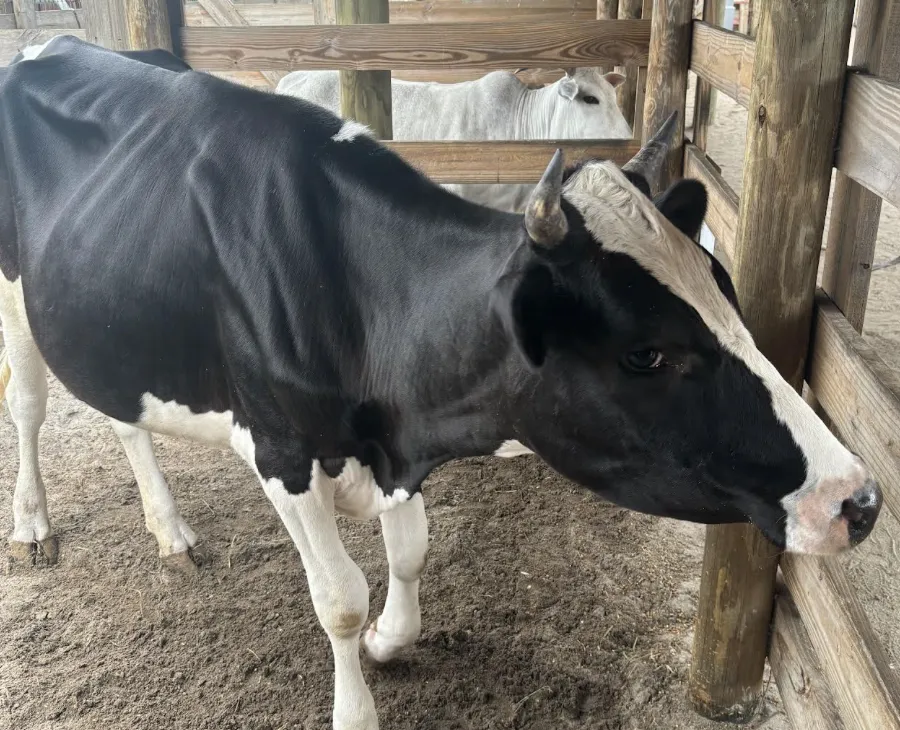
Dairy Cow "Bermuda"
by: Marina Santos
Bermuda (Dairy Cow)
There are several breeds of dairy cows, including Holstein, Jersey, Guernsey, Brown Swiss, and Ayrshire. Can you guess which breed is the most common and known for their large size and high milk production?
If you guessed Holstein, you are correct!
Overview:
Holstein cows originated in the Netherlands approximately 2,000 years ago. Two breeds of cattle, black animals from the Batavians (present-day Germany) and white animals from the Friesians (present-day Holland), were crossed to create a new breed of cattle.
Dairy cows may be found either in herds or dairy farms, where dairy farmers own, manage, care for, and collect milk from them, or on commercial farms.
Their natural environment is a pasture, and it is where they are most comfortable lying down, grazing, and chewing cud (or “ruminating”)
Dairy cows evolved from Aurochs. They once ranged throughout Asia, Europe and North Africa. They evolved into two types of domestic cattle, bos indicus and bos taurus, (our cow, Bermuda.)
Physical Description: A mature cow weighs about 1,500 pounds and stands 58 inches tall at her shoulder. One of the most prominent features of dairy cows is their udder, which is the milk-producing organ. They typically have well-developed udders with four teats, one for each quarter of the udder. Healthy dairy cows exhibit a sleek and shiny coat, bright eyes, and alert demeanor.
Diet and Eating Habits: Dairy cows are herbivores, primarily feeding on pasture, hay and silage. Adequate water intake is essential for dairy cow health and milk production therefore, they may consume large quantities of water, especially during hot weather and lactation. Dairy cows have a unique
digestive system that includes a large fermentation chamber called the rumen. They exhibit a behavior known as "rumination," where they regurgitate and rechew their food to aid in digestion, allowing them to help break down fibrous plant material and extract nutrients from the feed.
Behavior and Personality:
Dairy cows are social animals that form strong bonds within their herd. They often engage in social interactions, such as grooming each other, playing, and resting together. Dairy cows thrive on routine and predictability in their environment, so regular feeding times, milking schedules, and management practices help reduce stress and promote comfort and well-being.
Domestication and Uses:
Dairy cows are primarily raised for their milk, which is processed into various dairy products such as cheese, butter, yogurt, cream, and ice cream. Dairy cow breeding programs focus on improving milk production, milk quality, reproductive efficiency, and other desirable traits through selective breeding and genetic technologies.
Cultural Significance:
Dairy farming has been a longstanding tradition passed down through ancient civilizations such as Mesopotamia, Egypt, and the Indus Valley. Folklore and mythology in various cultures feature stories and legends about cows, highlighting their cultural importance and spiritual symbolism. Dairy cows and milk production are often depicted in paintings, literature, poetry,music, films, and advertising campaigns, reflecting their cultural resonance and aesthetic appeal.
Economic importance:
Dairy products provide essential nutrients such as protein, calcium, vitamins, and minerals, contributing to food security and nutrition for populations worldwide. Access to affordable and nutritious dairy products helps address malnutrition, especially among vulnerable groups such as children, pregnant women, and the elderly. Dairy farming can provide a stable source of income for farmers, as milk production is less susceptible to price fluctuations compared to crops or commodity markets.
Conservation status:
While dairy cows themselves are not assessed for conservation status like wild species, efforts are made to ensure their genetic diversity, welfare, and sustainable management to support agricultural resilience and food security. They are extensively bred and managed for milk
production in agricultural systems worldwide. The population of dairy cows is generally stable due to ongoing breeding efforts and demand for dairy products.
Takeaway:
A dairy cow is a great investment for your family to look into! Having your own dairy cow provides your family with a constant supply of fresh, high-quality milk which contains essential nutrients that contribute to a healthy diet for all family members. Beyond meeting your family's milk needs, you may have the opportunity to generate additional income by selling surplus milk, dairy products, or breeding stock. Caring for a dairy cow requires
dedication, responsibility, and daily commitment, which can be a rewarding experience for family members to work together in caring for the cow, fostering bonds and teaching valuable life skills such as empathy, work ethic, and problem-solving.
